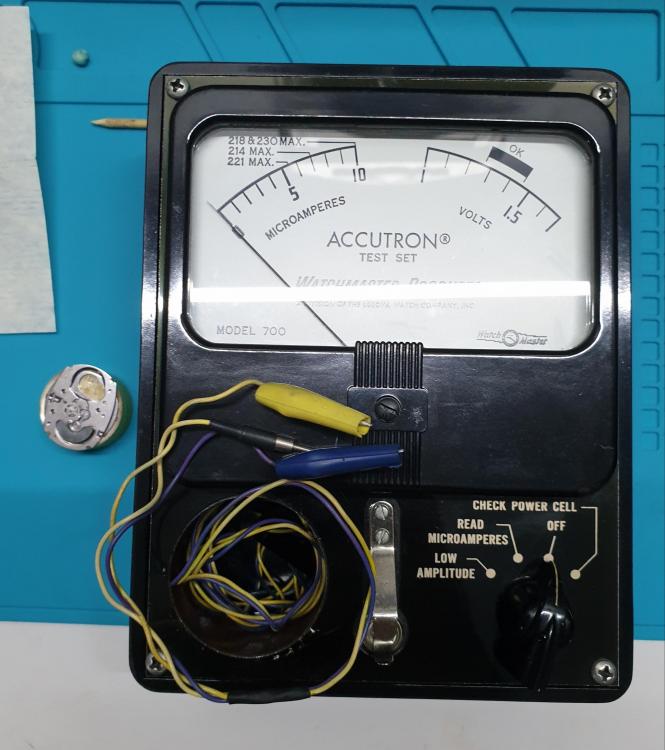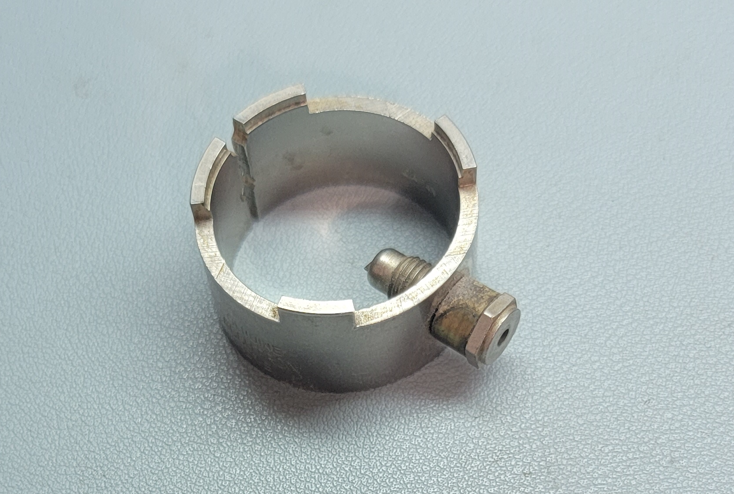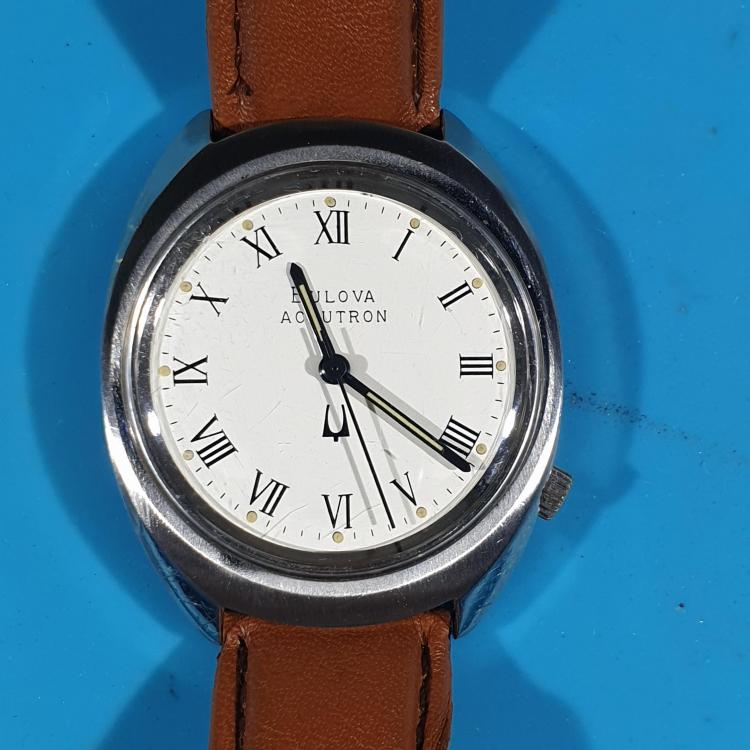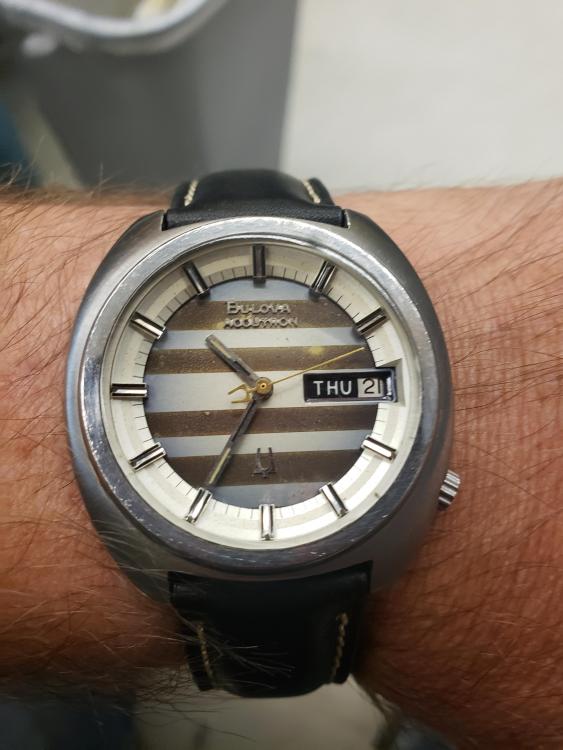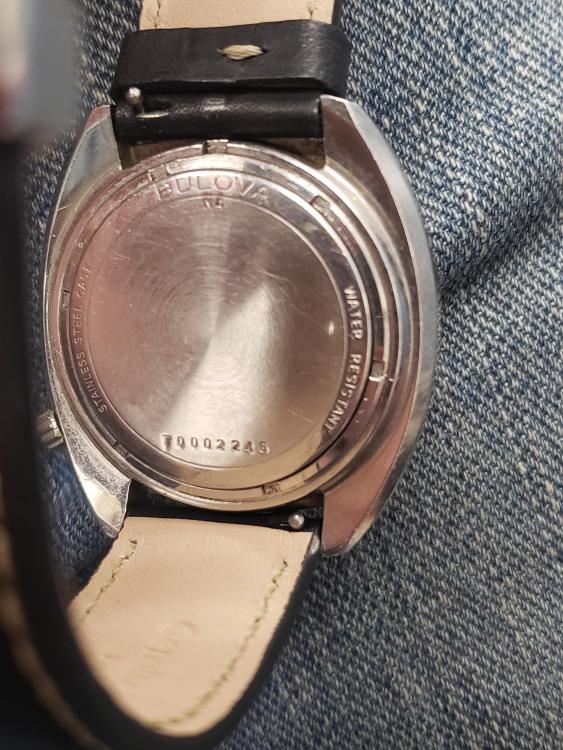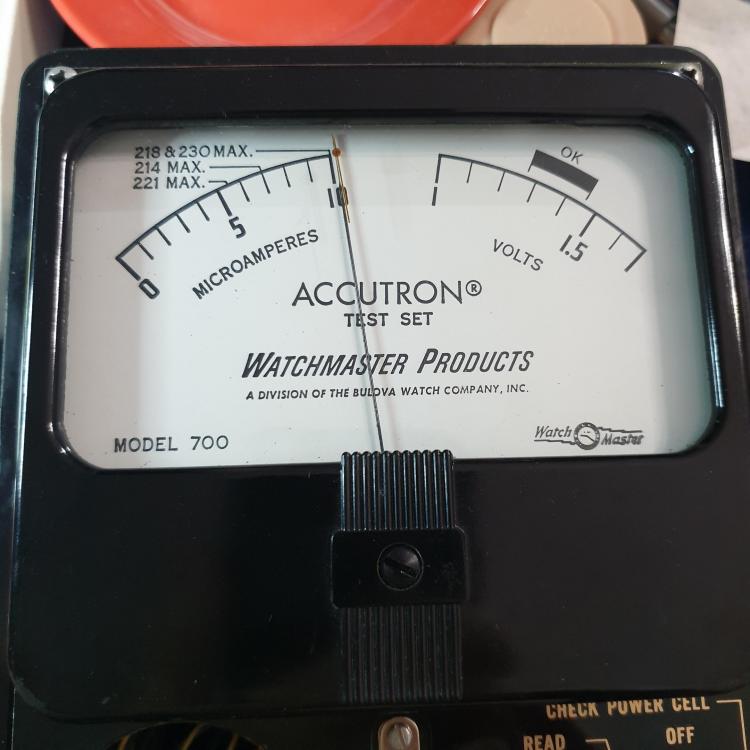Search the Community
Showing results for 'accutron' in topics.
-
Bulova Accutron 2180 2181
markr replied to markr's topic in Quartz and Tuning Fork Battery Operated Watches
I bought a Accutron 600 tester. Now I need to learn how to use it. -
Bulova Accutron 2180 2181
HectorLooi replied to markr's topic in Quartz and Tuning Fork Battery Operated Watches
https://www.ebay.com.sg/itm/VINTAGE-ACCUTRON-MODEL-700-WRIST-WATCH-REPAIR-TEST-TOOL-SERVICE-KIT-/384557962006?mkcid=16&mkevt=1&_trksid=p2349624.m2548.l6249&mkrid=711-127632-2357-0 If you place a battery in the test clip, it will provide power at the test leads to power up the watch under test. The meter gives a reading of 25 microamps FSD. I guess you could use an analog multimeter on the 50 microamp range but then the needle would hardly move. -
Bulova Accutron 2180 2181
HectorLooi replied to markr's topic in Quartz and Tuning Fork Battery Operated Watches
Go download a copy of the manual. You can find it on the internet. Also, read up on the theory of how a tuning fork watch works and how to index the watch correctly. There are some videos on YouTube on servicing tuning fork watches too. I remember I read everything I could find on the internet on the subject and watched every video on servicing tuning fork watches too. Then I put in on the back burner and let it stew for a few months. A tuning fork watch is totally different from mechanical and quartz watches, although background experience on working on other components like keyless works, motion works and calendar works would be a great help. A microscope of at least 20X magnification is essential. If you have an Accutron model 700 test meter, you won't need a variable power supply. But a normal multimeter isn't going to work. As for the watch that is humming, if the hands are not moving, it's better to remove the battery before the index wheel gets damaged. I'm no expert on Accutrons, but I'm here to help if you need it. Good luck. -
Bulova Accutron 2180 2181
HectorLooi replied to markr's topic in Quartz and Tuning Fork Battery Operated Watches
Be very careful with the index and pawl fingers. And don't hold the index wheel anywhere except by the arbor. Do you have an Accutron test meter? -

For me it's always been quartz
KarlvonKoln replied to Dxnnis's topic in Chat About Watches & The Industry Here
I work on no end of both. And I keep rediscovering that the more one knows about something, the more one can appreciate it. I specialize in antiques, and love to work on them. There are many old mechanicals which can be made very accurate, and I respect that. But as others have mentioned, for me it is also about the artistry. I adore the ways that the watchmakers of the Victorian and Edwardian eras used to decorate the movements. All the brushing on the nickel surface, the damaskeening, the engine turning, the fancy blackletter script of the maker's name, and so on. And just the overall pride in craftsmanship that is so evident throughout many of them. But I've also worked on really nice quartz movements. The more I learn about the Accutron tuning fork regulated watches, the more I appreciate that level of precision. And the Seiko kinetics are very impressive too, a sort of hybrid automatic-quartz with the oscillator charging the battery/capacitor. I confess, I've learned to like working on those too. I don't, however, get much thrill working on a run-of-the-mill, standard, battery-operated SMQ. But I respect what they can do. It's hard not to. So yes, for me, I like both. But certainly in different ways. Truthfully, the passion really comes out when I'm working on an old pocket watch. -

My current project: Jacques pocket watch
JGrainger replied to KarlvonKoln's topic in Your Walkthroughs and Techniques
That's terrible.. I believe a similar thing once happened to my grandad's Zenith.. and my grandma's Accutron gained a quartz movement at some point.. eventually I'm hoping to replace the dial / install another Accutron. It's frustrating to see these things happen - good luck in getting this sorted for your friend. -
There are many pulse testers available online. Get one that can check battery voltage, do line release and test for a motor pulse. Some of the newer ones can even test the timing accuracy. To test the coil, all you need is a multimeter set to resistance testing mode. But to test the current consumption of the circuit, I'm afraid there is no easy way. I use a Bulova Accutron test meter which was designed to test tuning fork watches but can be used to give a rough idea of the consumption current. A proper quartz watch testing machine, like those made by Witschi, is not something that a hobbyist would buy. My mentor explained to me why a professional watchmaker might not want to buy a Witschi quartz tester. If you test a watch that your customer brings in and pronounce it defective and then the customer brings it to another watchmaker who just replaces the battery and charges for it, the customer would think you are incompetent. Then when the battery fails after 6 months, he would just replace the battery again and tell you if it dies in six months again, you'll need to service the watch or buy a new one.
-
Just checked ebay for sold Accutron 214 bowtie watches. Most sold for $85 to $185 and one sold for $300. I searched more accutron repair sites and $300 is typical, just for a cleaning and lube. If it needs any parts like coils, cost could easily be $500 or more and that doesn't include any cosmetic work. I'm going to sell is as non-working.
-
Measuring the current consumption of a watch can be difficult and usually involves expensive equipment. The le arsi tester is an economical way of accomplishing this. It is able to provide a variable power supply and by the sound indicator and LEDs, give an indication of the current consumption. I was going to buy a le arsi tester but then I discovered that the Bulova Accutron tester that I already owned could do that job too. Putting an appropriate battery into the battery test clip would also give the correct voltage to power the watch under test. The deflection of the meter will show the current consumption. In this way, the static and dynamic current can be measured. Accutron testers do come up for sale on ebay occasionally. Sometimes for less than a le arsi tester.
-
Accutron: Seconds band moves. Hour minute don’t move
nickelsilver replied to standarsh's topic in Watch Repairs Help & Advice
Which model is it? When was it last serviced? Accutrons are backwards of mechanical watches, in that you have the power source turning the escape wheel, which then powers the train up through the hands. In a mechanical watch there is an increase in speed and a reduction of torque from each gearing to the next, so there is almost no power on the escape wheel. In an Accutron the tiny power and movement of each vibration of the tuning fork is increased by 7 or 8 fold at each gear set, so that at the hour and minute hands there is tremendous power. The instantaneous date system on a 218 model will shake your wrist! And it would stop or hinder a regular mechanical watch. The upside is a well adjusted Accutron is very reliable and runs for years and years, the downside is that they will run long after the lubrication had dried and grind the pivots to dust. I suspect the friction between the driving wheel and canon pinion has become weak, and the canon pinion and hour wheel are sticky, so the watch runs but doesn't move the hands. As the seconds pinion is before this intersection it continues to move, and the hand setting works since that is another gearing that drives the canon pinion directly. As it does run, it should just need a service. But the longer it runs in this state the more potential damage that can be done. -
Ladies Accutron tuning fork watch
JohnR725 replied to HectorLooi's topic in Watch Repairs Help & Advice
I renamed the file when I went searching for it all I had was a PDF labeled 221. then it doesn't even start off like one of their normal manuals somebody gives us a bonus page and conveniently skips over the title page. Accutron 221.pdf -
Ladies Accutron tuning fork watch
WatchMaker replied to HectorLooi's topic in Watch Repairs Help & Advice
Worth just searching for Bulova 221. The zero on the end for 2210 indicates no complications but most references are just to 221. With that you'll find articles like... http://mybulova.com/sites/default/files/file/1974_Power_Cell_Replacement_Guide.pdf https://reference.grail-watch.com/movement/accutron-221 .. which look like they could be handy. Also Google watchguy bulova 221 which should point you to a Technical Letters reference of interest. -

Ladies Accutron tuning fork watch
oldhippy replied to HectorLooi's topic in Watch Repairs Help & Advice
I found this on the net. Accutron 2210 uses Maxell 329 SR731SW. I also found many asking for the service manual which many can't find. I haven't found any leads to one, sorry. -
This is my latest acquisition. All cleaned up and lubricated. It still runs about a minute fast per day. I'm not sure if it's a phasing problem or the oscillating frequency is off. I'll probably test it with my frequency meter to find out. Is there any timing machine that can be used to regulae an Accutron other than a Vibrograf? I don't think I'd want to repair/ restore a Vibrograf and go through the hassle of using paper tracings.
-
I think it might help to have a definition of what the word means which is not tuning fork watch but this ACCUTRON stands for “ACCUracy through ElecTRONic". Or basically it's a nifty word that sells watches whether it has a tuning fork or not. then for phasing are using the instructions in the book or the instructions at the website below? the reason I point this out the website below tells how to phase the watch for silver cells. http://members.iinet.net.au/~fotoplot/accphs.htm
-
What to do about worn Timex crowns
HectorLooi replied to RichJensen's topic in Watch Repairs Help & Advice
NOS stems and donor watches are getting increasingly harder to find. I've been toying with the idea of removing the old crown and cutting threads on the stem to fit an OEM crown. One day I'll get down to doing it. Right now I have an Accutron crown that sticks out by a little more that a millimeter. Obviously it doesn't belong to this case. And it's also a pressed on crown. Hmmm... -
Thanks Graziano. I've watched of them before. But if you notice, when it came to the part when he set up the Accutron test meter to do phasing, the video was abruptly cut out ( end of Part 3). The video then continues with the casing up and finishing of the watch.
-
Thanks Graziano. That was very informative. Have you serviced any tuning fork watches before? Would you kindly share your experience? As for Nucejoe's request for a service walk through, I would be too embarrassed at this moment to post one. I was just stumbling around clueless. Maybe after a few more Accutron repairs, I may dare post one.
-
Today I'm wearing my Accutron Hummer. It is a 1974 218D. This is technically a resto-mod as I sourced the movement, case, dial and hands separately though they are all period correct. The strap is a super comfy aftermarket leather one with a butterfly clasp. It's a bit finicky to keep consistantly running. It definitely needs a proper service by an experienced Accutron person. It will randomly stop humming and it takes several taps on the side of the case to get it started again. I have an Omega Hummer on layaway that I should have in my possession by December, I'll be sure to share that too.
-
Accutron tuning fork 218 and 224
HectorLooi replied to HectorLooi's topic in Watch Repairs Help & Advice
Would the coil resistance reading give any clue as to which oe is broken? I read that there are people specializing in recoiling Accutron coils. Have you found anyone able to that? -
From mybulova.com 1962 The Accutron Tuning-fork watch becomes the first wristwatch certified for use by railroad personnel. 1962 is also the year that Bulova introduces its Caravelle line of jeweled watches. Designed to retail at $10.95 to $29.95, Caravelle competes with non-jeweled watches in the same price range.
-
eta movements stopping just before date change
Alastair replied to avantbiy's topic in Watch Repairs Help & Advice
Cannon pinion/centre wheel slip is very common on Accutron 218 series.... A nice bodge to prove it is remove the wheel take it off the cannon, reverse it and refit. You may then get it working again, but make sure you oil/lube it before use, the interface between the cannon and centre-wheel... -
Accutron tuning fork 218 and 224
HectorLooi replied to HectorLooi's topic in Watch Repairs Help & Advice
I balanced the tuning fork last night. I removed the gear train and just applied power to vibrate the fork. I adjusted the "regulator weights" until I got the oscillator to run with minumum current. I then put back the gear train and proceeded to phase the watch as per the instructions in the Bulova service manual. This time I managed to get the index wheel to run-stop-run. Hopefully the watch is phased correctly now. I did try connecting the spare +ve lead wire from the Accutron test meter to the test point on the IC. But the meter needle went off the scale and I aborted. 20210616_215716.mp4



